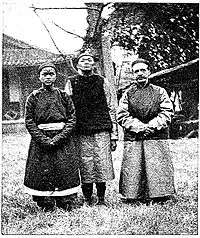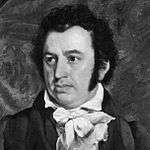Sam Pollard
| Samuel Pollard | |
|---|---|
| Born |
20 April 1864 Camelford, Cornwall, England |
| Died |
16 September 1915 (aged 51) Weining Yi, Hui, and Miao Autonomous County, Zhaotong, Yunnan, China |
Samuel Pollard (20 April 1864 in Camelford, Cornwall – 16 September 1915 in Weining, China), known in Chinese as Bo Geli (Chinese: 柏格理; pinyin: Bó Gélǐ) was a British Methodist missionary to China with the China Inland Mission who converted many of the A-Hmao (closely related to the Hmong) in Guizhou to Christianity, and who created a Miao script that is still in use today.
Biography
Born the son of a Bible Christian Church preacher, Sam Pollard initially aimed for a career in the civil service. However, a conference in London in 1885 encouraged him to instead become a missionary.[1] He was appointed a missionary in 1886, left the United Kingdom for China in 1887, and was posted to Yunnan province in 1888. He remained in China, as a missionary, until his death from typhoid.
In 1891 he was posted to a newly opened Bible Christian mission station in Zhaotong (referred to in contemporary sources in Wade–Giles as Chaotung),[2] where he married Emmie Hainge. He began a Christian movement with the Big Flowery Miao in 1905 that spread to Zhaotong. Pollard also invented a script for the Miao languages called the Pollard Script (also sometimes called the "Ahmao script"). He credited the basic idea of the script to the Cree syllabary, "While working out the problem, we remembered the case of the syllabics used by James Evans, a Methodist missionary among the Indians of North America, and resolved to do as he had done".[3] He also gave credit to a non-Miao Chinese pastor, “Stephen Lee assisted me very ably in this matter, and at last we arrived at a system”.[3]
Pollard never claimed any divine inspiration or vision in creating the script. Rather, he left a record of hard work, advice from others, and ideas from other scripts. At the beginning, he wrote, he “made an experiment in getting out a written language for the Miao”, even writing out some symbols in his diary.[4] He credited the basic idea of the script to the Cree syllabary (discussed above), “While working out the problem, we remembered the case of the syllabics used by a Methodist missionary among the Indians of North America, and resolved to do as he had done”.[3] He also gave credit to a Chinese pastor, “Stephen Lee assisted me very ably in this matter, and at last we arrived at a system”.[3] In another document he wrote “Mr. Stephen Lee and I are attempting to reduce the Miao language to a simply system of writing. The attempt may succeed or it may end… stillborn”.[5] He asked himself in his diary “How shall I manage to distinguish tones?” then later wrote how he had found the solution, adopting an idea from Pitman’s shorthand.[6] In listing the phrases he used to describe the process of creating the script, there is clear indication of work, not revelation: “we looked about”, “working out the problem”, “resolved to attempt”, “assisted”, “at last we arrived at a system”, “adapting the system”, “we found”, “solved our problem”.[7] In all of this, we see no hint of specific revelation or any vision, only intellectual labor.

He used it to translate the New Testament. The script was unique in the fact that it used the initial consonant of a syllable, with the vowel placed above or below it, in order to indicate which tone the vowel was.[8]
Pollard received pressure from some British sources that if the Roman script was not suitable, he should consider using the Burmese alphabet.[9] He did not accept this suggestions, but Pollard did leave the door open for switching over to Roman letters, writing in 1906, "It is quite possible later on to turn our system into Romanised, where there is a successful Romanised system in use which will solve the tone difficulty".[9] A large part of Pollard’s motivation for creating his script was to have a way to adequately mark the sounds of the language, especially the tones. It has remained in use for 90 years, despite efforts to supersede it.[10]
During his mission he travelled extensively, founding churches, training other missionaries, performing the role of language examiner, and arguing the causes of Miao Christians.
Death
After Pollard's death in 1915, he was buried in the mountains near the Shimenkan mission station, contemporary Weining Yi, Hui, and Miao Autonomous County. The mission prospered for another 35 years until 1950, when the CCP ordered all English missionaries to cease proselytizing and leave the country. His grave and the county were closed to foreigners until 1995, when Xinhua announced that work had been taken to restore Pollard's tomb which they now declared to be a national monument.[11]
Dedications
The 100,000-square-foot (9,300 m2) main building at the Hopkins-Nanjing Center in Nanjing, China is known as the Samuel Pollard Building. It houses the Center's library, classrooms and conference space, and administration offices.
The building was dedicated in 2007 as part of the Center's twentieth anniversary celebrations, which included keynotes by former Secretary of State Henry Kissinger and former Chinese Foreign Minister Qian Qichen.
Bibliography
- Pollard, Sam; Smith, Henry; Dymond, F J (1909). The Story of the Miao. United Methodist Magazine. republished posthumously as:
- Pollard, Sam; Smith, Henry; Dymond, F J (1919). The Story of the Miao. London: Henry Hooks.
- Pollard, Sam (1913). Tight Corners in China.
- Pollard, Sam (1921). In Unknown China: observations, adventures and experiences of a pioneer missionary.
- Pollard, Sam (1954). R Elliott Kendall, ed. Eyes of the Earth: the diary of Samuel Pollard. London, Cargate Press.
See also
References
What supports what
- ↑ Mundus
- ↑ Morrison 1895, p. 121
- 1 2 3 4 Pollard 1919, p. 174
- ↑ Enwall 1994, p. 1.104
- ↑ Enwall 1994, p. 1.105
- ↑ Enwall 1994, pp. 1.170, 171
- ↑ Pollard 1919, p. 174,175
- ↑ Dingle 1911, p. 73
- 1 2 Enwall 1994, p. 1.108
- ↑ Yu Suee Yan, "The Story of the Big Flowery Miao Bible," The Bible Translator 62.4 (2011), pp. 209-212.
- ↑ Becker, Jasper (2000). The Chinese. John Murray. p. 30.
Sources used
- Enwall, Joakim (1994). A Myth Become Reality: History and Development of the Miao Written Language, two volumes. (Stockholm East Asian Monographs, 5 & 6.). Stockholm: Institute of Oriental Languages, Stockholm University.
- Hudspeth, Will (1937). Stone-Gateway and the Flowery Miao. London: The Cargate Press.
- Pollard, Samuel (1919). Gathering up the fragments. London: Hooks.
- Dingle, Edwin John (1911). Across China on Foot (republished BiblioBazaar, LLC, 2009 ed.). London: Henry Hooks & Co. ISBN 978-0-559-10338-4. — Dingle describes how Sam Pollard used positioning of vowel marks relative to consonants to indicate tones
- Morrison, George Ernest (1895). An Australian in China (republished BiblioBazaar, LLC, 2008 ed.). London: Horace Cox. ISBN 978-0-554-51690-5. — Morrison recounts meeting Sam Pollard and his wife at the Bible Christian Mission in 1894
- "Old Shebbearian News". Archived from the original on 9 April 2005. Retrieved 29 July 2005. — reports on an article in The Sunday Times describing the continuing influence of the work of Sam Pollard after his death
- Crofts, Daniel W. "The Hei Miao, the Hua Miao, and the Protestant "Civilizing Project" in Early-Twentieth-Century Guizhou". AAS Annual Meeting 2005, China and Inner Asia session 168. Retrieved 29 July 2005. — quotes Sam Pollard in his efforts to instil a "new-born sense of shame" into his converts, to curb behaviour that he regarded as being drunkenness and promiscuity
- Lemoine, Jacques. "Ethnicity, Culture, and Development Among Some Minorities of the People's Republic of China" (PDF). University of Hong Kong Libraries. Retrieved 29 July 2005. — Lemoine reports that after 1949 the Pollard script was retained as a symbol of cultural identity and pride
- Peter Mannion. "Re: I want to know Samuel Pollard". Pollard Family Genealogy Forum at genealogy.com. Retrieved 29 July 2005.
- "Sam Pollard". School of Oriental and African Studies Library. Retrieved 29 July 2005. — the School of Oriental and African Studies Library holds most of Sam Pollard's notes, diaries, letters, and papers
Further reading
- Grist, William Alexander (1921). Samuel Pollard. Pioneer Missionary in China. London: Henry Hooks.
- Pollard, Walter (1928). Sam Pollard, a hero of China. London: Seeley, Service & Co.
- Hayes, Ernest H (1946). Sam Pollard of Yunnan: The Pioneer Series. Wallington: Religious Education Press., also published as:
- Hayes, Ernest H (1947). Sam Pollard of Yunnan. Carwal Publications.
- Zai Wei Zhide Zhongguo (In Unknown China). Yunnan Minorities Press. 2002. ISBN 7-5367-2353-9. — full Chinese translations of books about the ministry of Po Geli (Sam Pollard) including The Story of the Miao, In Unknown China, Stone Gateway, and the Flowery Miao
- Crofts, Daniel W. (2005). "The symbols and sounds of the Ahmao script" (PDF). AAS Annual Meeting 2005, China and Inner Asia session 168. Retrieved 29 July 2005.
- Parsons, R Keith. "The people called "A-hmao" and their writing". A-Hmao introduction. Retrieved 29 July 2005.
- Daniel H. Bays, ed. (1996). Christianity in China: From the Eighteenth Century to the Present. Stanford University Press. — Part II includes Norma Diamond's study of Sam Pollard's work
- Samuel Pollard: missionary supreme, born 20 April 1864; a centenary tribute. 1964. OCLC 24160324.
- Kendall, R Elliot (1948). Beyond the Clouds. The story of Samuel Pollard of South-West China. Cargate Press.
- Pollard, Ernest C. (1993). Sermons in Stones. The Woodburn Press. — Written by Samuel Pollard's son, a well-known professor of physics and biophysics. "Sermon" 17, The Story of Sam Pollard, written for Atheists offers a very personal look at Sam Pollard's life and motivation
- Stone-Gateway and the Flowery Miao. London: The Cargate Press. 1937.
- Moody, Edward H (1956). Sam Pollard. Grand Rapids: Zondervan and London: Oliphants Ltd.
- Covell, Ralph R. (1999). "Pollard, Samuel". In Gerald H. Anderson. Biographical dictionary of Christian missions. Wm. B. Eerdmans Publishing. p. 542. ISBN 978-0-8028-4680-8.
- Yu Suee Yan. (2011.) The story of the Big Flowery Miao Bible. The Bible Translator vol. 62, no. 4: 207-215.
